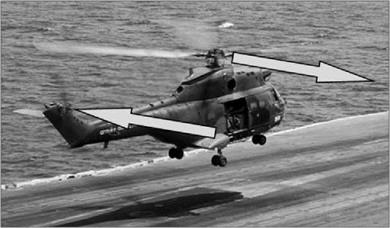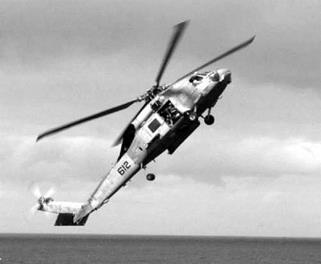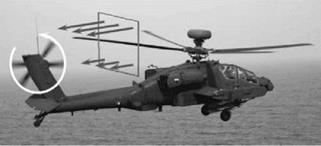6.4 Tail Rotors[5]
The vast majority of helicopters are of the single main and tail rotor type. So far, any discussion has focused, primarily, on the main rotor. It provides most of the forces and moments required
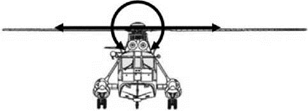 |
to fly successfully and under full control. However, it needs a mechanism for yaw control and this is where the tail rotor contributes. On a pure numbers basis, the main rotor provides control in 5 degrees of freedom:
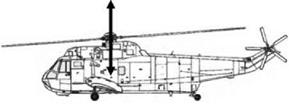
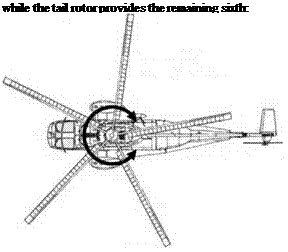 (c) Vertical motion
(c) Vertical motion
(d) Yaw
However, it has to provide this yaw control under very particular circumstances and in areas where the aerodynamic and dynamic forces on the blades are a real problem. It is positioned on a fin which is directly behind the main rotor hub and installation fairings. The tail rotor produces a thrust perpendicular to its disc plane which is reacted by a small lateral tilt of the
|
Figure 6.13 Puma hovering showing tail rotor thrust direction and opposing main rotor side force (Courtesy US Navy) |
main rotor in opposition. It is placed at a vertical location at approximately the same height as the main rotor head in order to minimize any subsequent roll coupling – see Figure 6.13.
Its location at the rear extremity of the airframe can lead to dangers in the event of extreme manoeuvres as exemplified by the rapid deceleration shown in Figure 6.14.
The position of the tail rotor, behind the main rotor hub and top fuselage, results in the forward flight incident flow not being uniform over the tail rotor disc. Figure 6.15 shows a window placed in front of the tail rotor with an indication of the incident mean flow velocity. Efficiency is usually associated with uniformity and the tail rotor is no different. In order to account for the higher flow at the top of the tail rotor disc and the consequent lower flow at the
|
|
|
Figure 6.15 Incident flow over tail rotor (Courtesy US Navy) |
bottom, a tail rotor rotational direction of backwards at the top would seem advisable. In most conventional helicopters, this is the case; however, there are exceptions. As will be discussed later, the early Westland Lynx helicopter had the opposite rotational direction which caused difficulties in side winds – in other words, there are differing reasons why this rotational direction has merits.
Because of the flight of a helicopter, a tail rotor has to operate in areas not experienced by the main rotor. The tail rotor has to overcome the effects of sideways flight (in either direction), autorotation and high-power climb. These conditions will require a pitch range of the order of 40°, see Byham [9]. This puts the blades at considerable pitch angles, which will introduce kinematic effects which are not normally experienced by the main rotor. One important effect is that of propeller moment.











